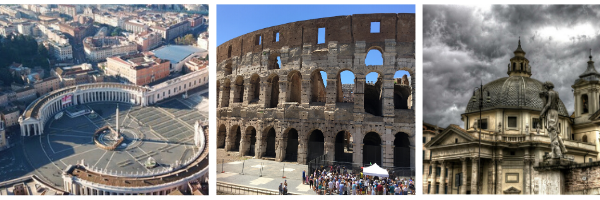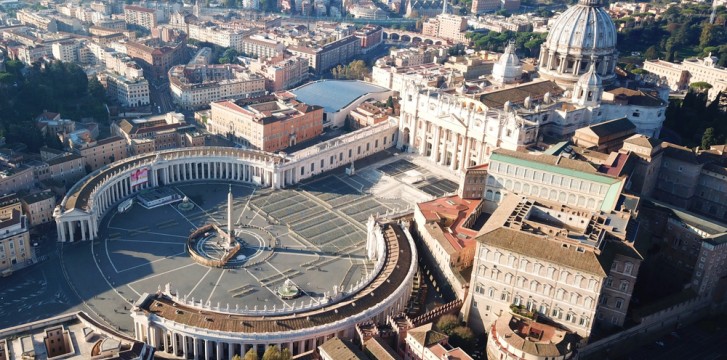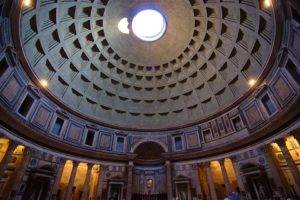Did you know that every last Sunday of the month Vatican Museums are free?!
The Vatican Museums are a popular tourist destination, and the admission fees can be quite steep. However, as an expat, you have the unique advantage of being able to visit the museums for free on the last Sunday of the month. This is a fantastic opportunity to explore the museums without breaking the bank.
To make the most of your free admission to the Vatican Museums, it’s important to plan your visit in advance. The museums can be crowded, so it’s best to arrive early in the morning to avoid long lines. You may also want to consider purchasing a guidebook or hiring a local guide to help you navigate the museums and learn more about the exhibits.
The free entrance time is: 9:00 – 12:30 closing 14:00. There is also possibility of guided tours upon reservation.
While you’re at the Vatican Museums, don’t forget to visit the Sistine Chapel. This famous chapel is home to Michelangelo’s masterpiece, the ceiling fresco, and The Last Judgment. The Sistine Chapel is a must-see for anyone visiting the Vatican Museums.
Another tip for expats visiting the Vatican Museums is to take advantage of the audio guide. The audio guide provides an informative tour of the museums and gives you a deeper understanding of the history and significance of each exhibit.
In addition to the Vatican Museums, Rome is home to many other cultural attractions, including the Colosseum, the Roman Forum, and the Pantheon. As an expat living in Rome, it’s essential to take advantage of these unique opportunities to explore the city’s rich cultural heritage.
If you’re an expat living in Rome, don’t miss the chance to visit the Vatican Museums for free on the last Sunday of the month. With a little bit of planning, you can make the most of your visit to one of the world’s most famous museums and immerse yourself in the history and culture of Rome.

Free Museum Admission in Rome Every First Sunday of the Month!
Rome is a city that’s rich in culture and history, and it’s no secret that its museums are among the best in the world. If you’re looking to explore the city’s museums without breaking the bank, then you’re in luck! Every first Sunday of the month, many of Rome’s state and civic museums offer free admission. In this guide, we’ll provide you with a comprehensive list of the free state and civic museums in Rome and what you can expect from your visit.
Before you plan your visit to any of the museums, it’s important to call ahead and make sure they’re open. Additionally, not all exhibitions may be included in the free admission offer, so it’s always best to check beforehand.
Here is a list of free state museums offering free entrance on the first Sunday of every month:
Museums and State Archaeological Sites
- Colosseo e Foro Romano / Palatino (with limited entry)
- Museo Nazionale Romano (Palazzo Massimo, Palazzo Altemps, Crypta Balbi, Terme di Diocleziano)
- Galleria Borghese (advance booking is always mandatory)
- Museo Nazionale Etrusco di Villa Giulia
- Galleria Nazionale Arte Moderna
- Museo Boncompagni Ludovisi
- Museo H.C. Andersen
- Galleria Nazionale d’Arte Antica Palazzo Barberini
- Galleria Nazionale d’Arte Antica Palazzo Corsini
- Galleria Spada
- Museo Nazionale di Palazzo Venezia
- Museo Nazionale di Castel Sant’Angelo (with limited entry)
- Museo Nazionale d’Arte Orientale “G. Tucci”
- Museo Nazionale Preistorico Etnografico “L. Pigorini”
- Museo Nazionale delle Arti e Tradizioni Popolari
- Museo Nazionale dell’Alto Medioevo
- Museo Nazionale degli Strumenti Musicali
- Terme di Caracalla
- Mausoleo di Cecilia Metella
- Villa dei Quintili
- Santa Maria Nova sull’Appia Antica
- Villa di Livia a Prima Porta
- Area Archeologica di Veio
- Scavi di Ostia Antica
- Museo Ostiense
- Castello di Giulio II
- Area Archeologica del Porto di Traiano
- Villa Adriana a Tivoli
- Villa d’Este a Tivoli
The ‘Musei Gratuiti a Roma’ event does not always include a visit to the exhibitions in progress, for which the special charge may remain in force.
Visiting these museums can be a great way to immerse yourself in Rome’s rich history and culture without spending a dime. It’s also an excellent opportunity to learn more about the city’s artistic heritage and its influence on the world.
Don’t forget, the Vatican Museums are also free on the last Sunday of every month, which can be another great way to explore Rome’s art and history. With a little bit of planning, you can take advantage of these free admission offers and experience all that Rome’s museums have to offer.
You can find tons of events, fun activities, and suggestions on our website and Social Media to meet and join groups of expats to share experiences and great moments with your friends, just by coming to our weekly events!
Learn Italian online and in-person in Rome
15 Must-Visit Museums, Galleries, and Cultural Sites in Italy
Here is the answer to the much asked question! The Vatican is the smallest state in the world but also one of the most famous. However, many do not know its history and wonder: why is the Vatican located in Rome?
The Vatican is a well known autonomous state, and also the smallest in the world, both in size and population. Officially born when signed by the Lateran Pacts in 1929, the Papal States have an ancient and fascinating history.

Why is the Vatican located in Rome?
The Vatican is on one of the hills of Rome; in ancient times it was an uncultivated and unhealthy area. However, according to Pliny the Elder, the humid climate that characterized the hill on the right side of the Tiber river favored the growth of a special plant: a magical holm oak. It is a legend, of course, which gives the place a certain charm. Agrippinia Maggiore then had gardens built there and later Nero built a private circus there. Where the Vatican stands today, the martyrs of the first Christians took place, among whom there was also Saint Peter, Jesus's apostle.
The legend has it that Saint Peter was buried in the same place where he was crucified, in the fourth century after Christ the basilica was built in his honor above his remains, by the will of Constantine. However, at the time, the remains of the Holy Apostle had not yet been found.
Where are the relics of St. Peter?
The location of the relics of the Prince of the Apostles remained a legend until 1950. In fact, on the initiative of Pope Pius XII - who also financed the operation, in 1940 research began on the remains of St. Peter under the Vatican. Archaeological excavations continued unabated - even during the Second World War - until 1949. A Roman necropolis was found in which numerous Christians and non-Christians were buried. In 1950, Pius XII himself announced the discovery of the bones of San Pietro. Fundamental were the studies of the archaeologist Margherita Guarducci who confirmed in 1965 the identification of the remains and the tomb that bore the epigraph in Greek "Pietro is here".
Read more about:
Free entry to museums and archaeological sites in Italy on the 1st Sunday of each month
A Comprehensive Guide to Visiting the Vatican Museums: Art, History, and Skip-the-Line Tips
15 Must-Visit Museums, Galleries, and Cultural Sites in Italy
Don’t forget to check out our Social Media accounts and Subscribe to our Newsletter so you can be updated with information customized for people who want to move, live, and love Italy! Also, check out these unique tours in Rome.
FAQs for Italian Citizenship by Marriage (2023)
Understanding the Tessera Sanitaria: Your Italian Health Insurance Card
Non-Married Partners: How to Obtain a Residence Permit in Italy as De Facto Cohabitants
How to get tax identification number for foreign citizens (Codice Fiscale)
How to register in Italy as an EU citizen
Mastering Public Transport in Italy
The Advantages of Dual Citizenship with an Italian Passport: Unlocking Boundless Opportunities
What you need to know about Visas and Permits to stay in Italy
Travelling to Rome on a budget?
Never fear – sightseeing in Italy’s magnificent capital city doesn’t have to cost the earth. Although many museums and monuments charge hefty admission fees, a surprising number of the famous sights are actually completely free. The doors of the city’s art-laden churches are flung open to all, ancient architectural wonders await around many a corner and it costs nothing to wander the historic streets, piazzas and parks. Check out our run-down of the best things to do in Rome without spending a thing:
1. Gaze heavenwards at the Pantheon, it’s an exhilarating experience to enter this iconic Roman building and look up at the largest unreinforced concrete dome ever built.
2. Pay homage at St Peter’s Basilica, the Vatican’s showcase basilica is free, though you’ll probably have to queue to get in. Once inside, look out for Michelangelo’s Pietà statue and Bernini’s baldachin (altar canopy).
3. Hang out on Piazza Navona, and enjoy the daily circus of street performers, artists and tourists acted out against a backdrop of baroque palazzi and ornate fountains.
4. People watch on the Spanish Steps, these grand stairs have long been a popular hangout – in the 1800s local beauties would parade up and down hoping to be picked as artists’ models.
5. Tell a lie at the Bocca della Verità, just keep your hands well out of the way. Myth holds that the mouth of the huge ancient face will slam shut on the fingers of anyone who fibs.
6. Throw a coin into the Trevi Fountain, according to legend, this will ensure your return to Rome. You and thousands of other people – on an average day about €3000 is chucked over people’s shoulders into the water.
7. Explore Villa Borghese, Rome’s most famous park is an oasis of shaded walkways, verdant corners and excellent museums.
8. Survey the city from Il Vittoriano, few views can top those from this massive marble monolith. You have to pay to take the lift to the top (€7) but there are plenty of free viewing spots.
9. Explore the Jewish Ghetto, this atmospheric area is studded with artisans’ studios, vintage clothes shops, kosher bakeries and popular trattorias.
10. Walk the Via Appia Antica, antiquity’s most famous road sets the perfect scene for a leisurely amble with its pine trees, Roman ruins, and eerie catacombs.
11. Lap up the atmosphere in Trastevere, this vibrant district buzzes well into the night as locals and tourists hang out on its picturesque lanes and piazzas.
12. Go on a free tour, New Rome Free Tour (newromefreetour.com) runs a daily walking tour of the historic centre.
13. Take a timeout at the Cimitero Acattolico, The last resting place of Keats and Shelley, Rome’s non-Catholic Cemetery is a serene spot to recharge your batteries.
14. Learn about Rome’s war at the Museo Storico della Liberazione, Rome’s Nazi occupation is recounted at this chilling museum housed in what was once the city’s SS headquarters.
15. Marvel at the mosaics in the Chiesa di Santa Prassede, the sparkling Byzantine compositions in this easy-to-miss church are among Rome’s most impressive.
16. Admire modern architecture in EUR, a highlight of the southern district is the Palazzo della Civiltà del Lavoro, a masterpiece of Italian rationalism known as the Square Colosseum.
17. Experience religious ecstasy at the Chiesa di Santa Maria della Vittoria, this roadside church is the unlikely setting for one of Italian baroque’s great masterpieces, Bernini’s Ecstasy of St Teresa.
18. Find architectural perfection on the Gianicolo hill, Bramante’s Tempietto (little temple) is considered the first great building of the High Renaissance.
19. Search out the Arco degli Acetari, discover the picture-perfect medieval courtyard hiding behind the dark Vinegar-Makers’ Arch (Via del Pellegrino 19).
20. Meet Moses at the Chiesa di San Pietro in Vincoli, Michelangelo’s muscular Moses is the star turn at this 5th-century church. Also here are the chains that St Peter supposedly wore in captivity.
21. Peek through the keyhole of the Priorato dei Cavalieri di Malta, and you’ll see St Peter’s dome perfectly framed at the end of a hedge-lined avenue.
22. Partake in the passeggiata, Head to Via del Corso and join the locals on their early-evening passeggiata (stroll).
23. Catch a Caravaggio at the Chiesa di San Luigi dei Francesi, better still, catch three. This baroque church is home to the St Matthew cycle, a trio of the artist’s earliest religious paintings.
24. Get into the swing on Campo de’ Fiori, by day, poke around the much-loved market; at night, grab a drink and see in the small hours with hundreds of like-minded revellers.
25. Seek light relief in the Quartiere Coppedè, with its turreted villas, fairytale towers, gargoyles and arches, this Art Nouveau neighborhood stands in contrast to Rome’s more serious sights.
26. Watch the world go by on Piazza del Popolo, there’s always something going on on this grand neoclassical square. Nearby, the art-rich Chiesa di Santa del Popolo is well worth a look.
27. Do a double take at the Teatro di Marcello, a dead ringer for the Colosseum, this ancient stadium looms over the Area Archeologica del Teatro di Marcello e del Portico d’Ottavia.
28. Investigate a crime scene at the Largo di Torre Argentina, modern investigators have identified the spot where Julius Caesar was murdered. It was in the Area Sacra on Largo di Torre Argentina.
29. Take in a concert during Estate Romana, Rome’s big summer event stages everything from concerts and dance performances to book fairs and late-night museum openings. Some are free.
30. Check out Piazza del Campidoglio, on the Capitoline Hill, Michelangelo’s exquisitely designed piazza is one of Rome’s most beautiful public spaces.
31. Look up at Trajan’s Column, this ancient landmark towers over the Imperial Forums. If you can make them out, the reliefs depict Trajan’s military campaigns.
32. Enjoy local colour in Garbatella, this sparky neighborhood presents a colourful front with its community gardens, faux baroque palazzi and red housing blocks.
33. Go jogging in the Circo Massimo, where once crowds cheered chariot racers in Rome’s largest arena, now locals come to stretch their legs.
Attractions that are free at specific times:
34. Colosseum, Palatino, and Roman Forum; first Sunday of the month.
35. Vatican Museums; last Sunday of the month.
36. All state museums; first Sunday of the month.
37. Pope’s weekly audience; every Wednesday morning.
38. Porta Portese market; every Sunday morning.
39. Palazzo di Montecitorio; first Sunday of the month.
40. May Day Concert; May 1
